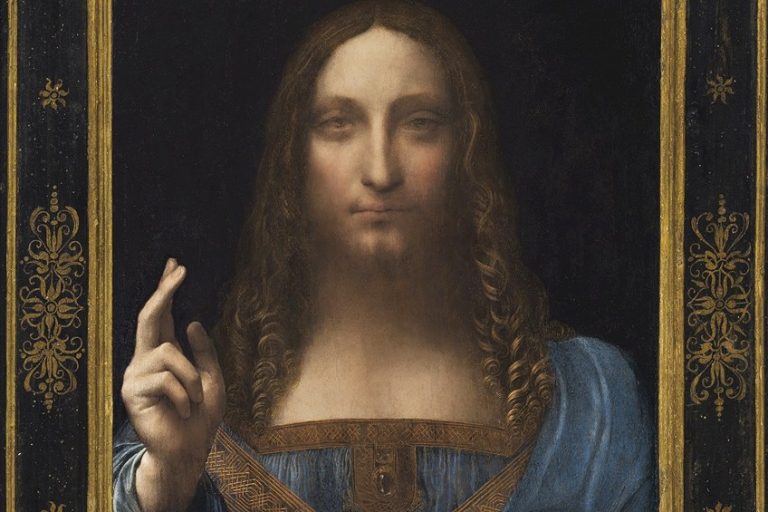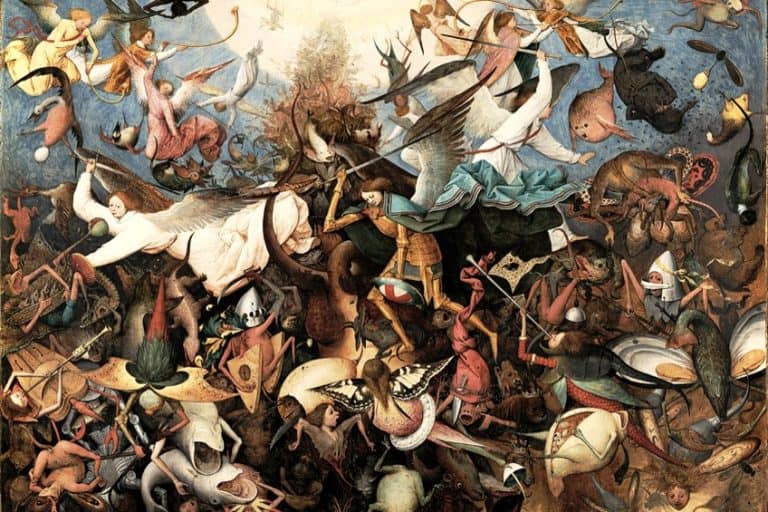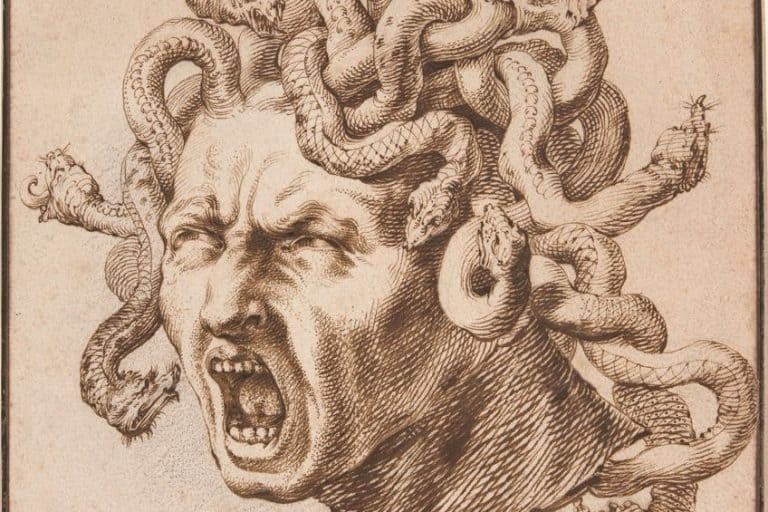Famous Picasso Paintings – Analyze His 12 Must-See Artworks
Pablo Picasso was arguably the most influential artist of the 20th-century, whose experimentation with representation and various art styles triggered a multitude of discussions in the art world. Picasso’s critical evaluation of form and technique can be seen in many of his famous artworks as he weaved through some of the most impactful art movements of the Modern era. Below, we will explore the 12 most famous Picasso paintings that provide valuable insight into the Spanish artist’s creative processes and experiences.
The Most Famous Picasso Paintings
Here is an overview of Picasso’s most important artworks:
| Title | Year | Medium | Dimensions (cm) |
|---|---|---|---|
| The Soup | 1903 | Oil on canvas | 38 x 46 |
| The Old Guitarist | 1903 – 1904 | Oil on canvas | 123 x 83 |
| Portrait of Gertrude Stein | 1905 | Oil on canvas | 100 x 83 |
| Les Demoiselles d’Avignon | 1907 | Oil on canvas | 243 x 233 |
| Still-Life with Chair Caning | 1912 | Oil on canvas | 29 x 37 |
| Ma Jolie | 1912 | Oil on canvas | 100 x 64 |
| Bowl of Fruit, Violin and Bottle | 1914 | Oil on canvas | 92 x 73 |
| The Three Musicians | 1921 | Oil on canvas | 204 x 188 |
| Three Women at the Spring | 1921 | Oil on canvas | 204 x 174 |
| Guernica | 1937 | Oil on canvas | 250 x 777 |
| Portrait of Dora Maar | 1937 | Oil on canvas | 92 x 65 |
| Self-Portrait Facing Death | 1972 | Crayon and pencil on paper | 65 x 50 |
The 12 Most Famous Picasso Paintings
Throughout his prolific career, Pablo Picasso created some of the most renowned artworks in the world. Today, he is a household name, with the majority of his works being housed in influential galleries all over. In the section below, we analyze 12 of his most well-known works, looking at everything from subject matter to potential meaning.
The Soup (1903)
| Date | 1903 |
| Medium | Oil on canvas |
| Dimensions (cm) | 38 x 46 |
| Where It Is Housed | Art Institute of Chicago, Chicago, United States |
The Soup is one of Picasso’s earliest works that portrays the artist’s intense despair defined as his “Blue period”. The painting was created at the same time as a series of other works discussing themes of deprivation, age, and disability. Picasso’s artwork conveys his concern surrounding the tragic events he witnessed as a child in Spain and was influenced by the religious art he was exposed to. Such influences included works by artists like El Greco and Diego Velázquez. The Soup is recognized as a painting that represented the visual codes of the greater Symbolism movement of the early 20th century.
Picasso often described his Blue Period artworks as “nothing but feeling.”
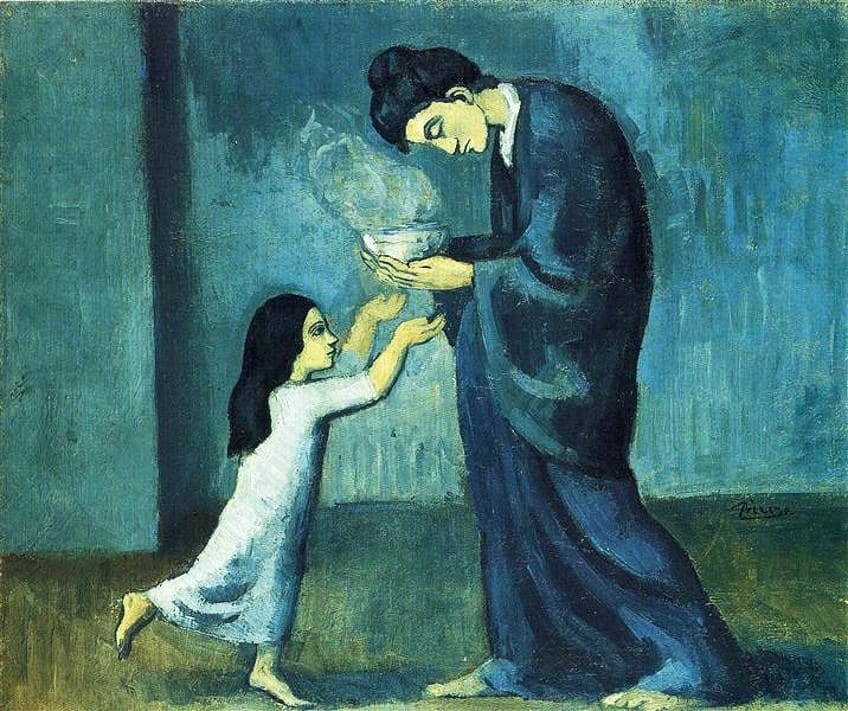
The Old Guitarist (1903 – 1904)
| Date | 1903 – 1904 |
| Medium | Oil on canvas |
| Dimensions (cm) | 123 x 83 |
| Where It Is Housed | Art Institute of Chicago, Chicago, United States |
The Old Guitarist is among the top three most famous paintings created during Picasso’s Blue period and is recognized by its melancholic and chilling blue atmosphere. The painting depicts an elderly man hunched over his guitar with torn and ragged clothing.
This famous image of an impoverished old man playing a guitar in the streets of Barcelona, Spain, is recognized by many as Picasso’s most touching piece.
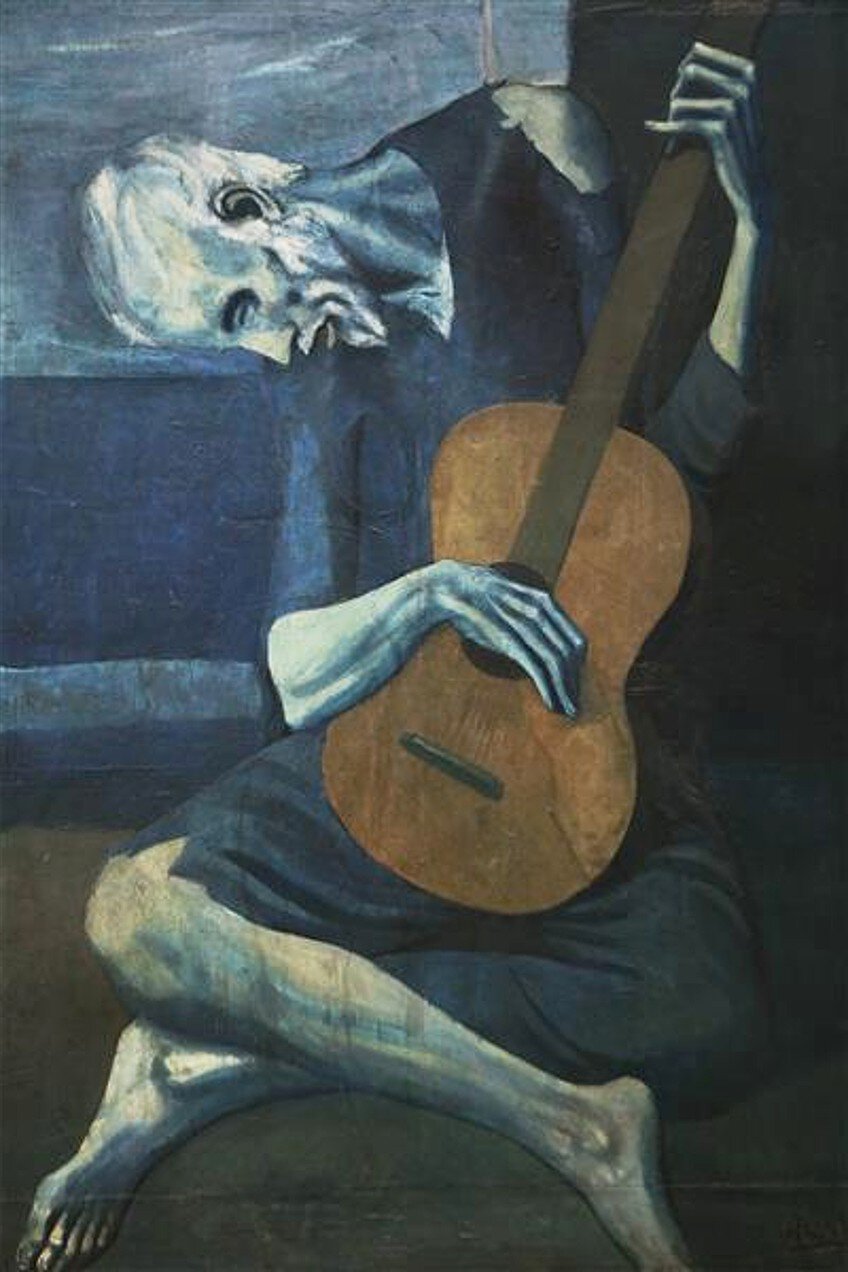
Portrait of Gertrude Stein (1905)
| Date | 1905 |
| Medium | Oil on canvas |
| Dimensions (cm) | 100 x 83 |
| Where It Is Housed | The Metropolitan Museum of Art, New York City, United States |
Picasso’s author, benefactor, and close associate Gertrude Stein was an important figure in his artistic growth. This famous Portrait of Gertrude Stein shows Stein dressed in her favorite brown velvet jacket and marked a turning point in Picasso’s technique. This shift was noted by the contours of Stein’s portrait, which appear chiseled in comparison to the flat elements of Picasso’s other Blue period and Rose period paintings. This approach was influenced by Picasso’s study of old Iberian sculpture.
Picasso’s growing fascination with the textures and contours of the human face are evident in his use of flat surface and color.
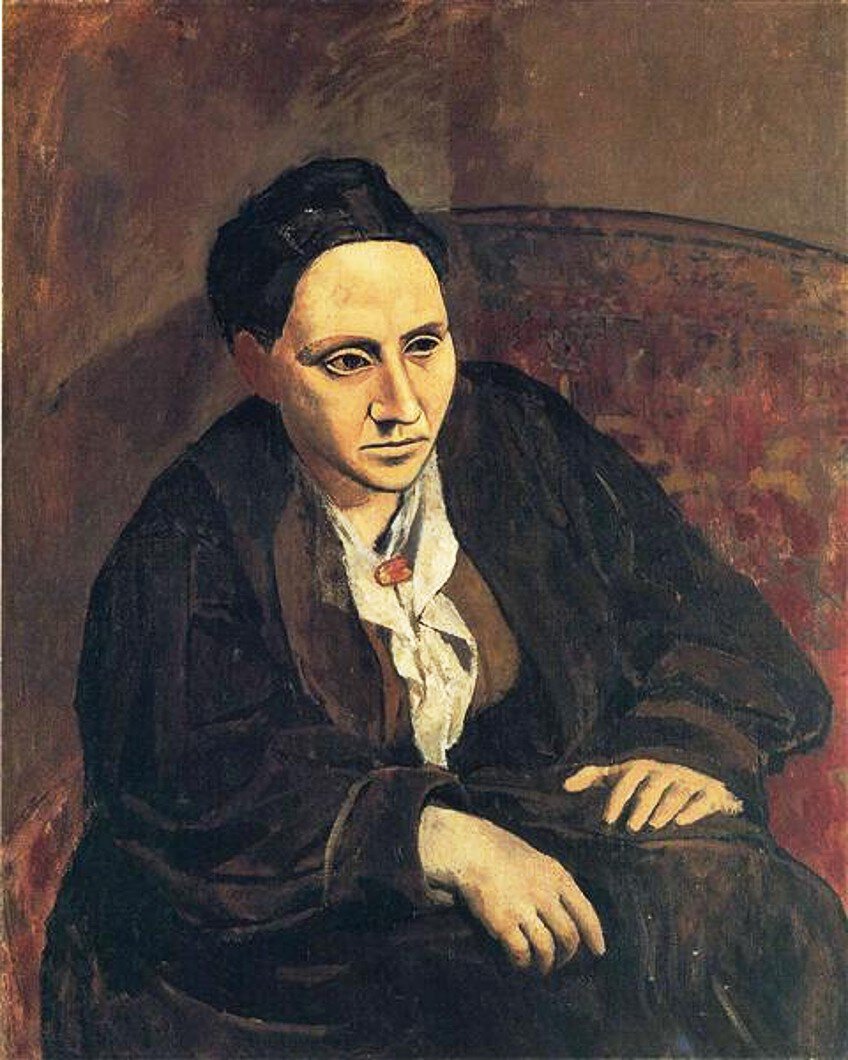
Les Demoiselles d’Avignon (1907)
| Date Completed | 1907 |
| Medium | Oil on canvas |
| Dimensions (cm) | 243 x 233 |
| Where It Is Housed | Museum of Modern Art |
Even Picasso’s closest artistic contemporaries were shocked by this piece, both in terms of subject and technique. Les Demoiselles d’Avignon was somewhat of a taboo painting with a concept that distorted the representation and form of five prostitutes. The concept of nude women was not unusual for the time but Picasso’s depiction of the women in a Primitivist style was uncommon and subject to intense criticism. The mask-like faces of some of the figures reveal Picasso’s love for Iberian and African mask art, implying that their sensuality is not just aggressive but also primitive, which was highly problematic not only for his appropriation of African styles as a form of objectifying women, but also for the lack of information around the identities of the women and their role in the painting.
Picasso abandoned the Renaissance’s use of three-dimensionality in favor of a severely flattened picture plane divided into geometric pieces. This technique was borrowed from the work of Paul Cézanne.
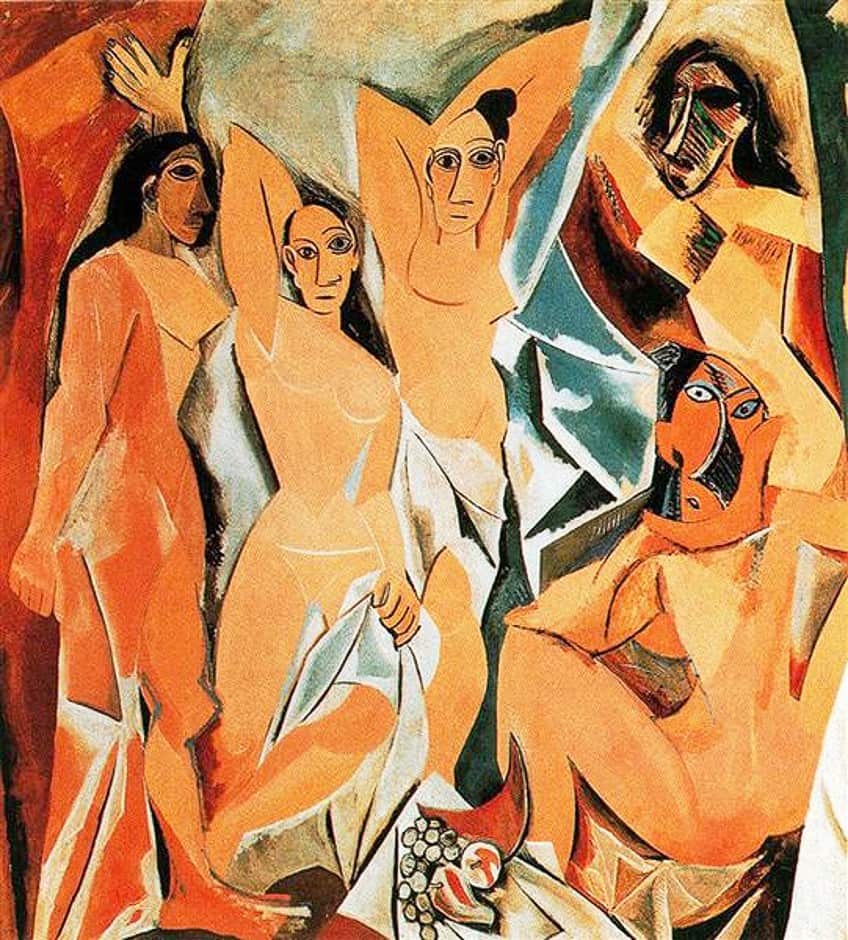
The thigh of the woman on the left, for instance, was portrayed in a Cubist style, as if it were viewed from multiple viewpoints at once. It is impossible to tell the leg apart from the empty space around it, which creates the sense that there is no clear element separating the foreground from the background. When the painting was finally exhibited to the public in 1916, it was criticized as completely immoral. Braque was one of few painters to analyze the painting in 1907 and resulted in his collaboration with Picasso. Les Demoiselles d’Avignon is recognized as an example of proto-Cubism since it predicted many of Cubism’s visual characteristics.
Still-Life with Chair Caning (1912)
| Date | 1912 |
| Medium | Oil on canvas |
| Dimensions (cm) | 29 x 37 |
| Where It Is Housed | The National Gallery, London, United Kingdom |
This well-known piece is often recognized as the first collage in Modern art. Picasso had previously included found objects in his works, but this was the first time that he did it with a comedic and dramatic intent. As the title of the work implies, the chair in the work is in reality a printed cloth and not a real chair caning. The rope that wraps around the painting is, in fact, real, and serves to imitate the carved border of a café table. The painting may also be considered as a pane of glass, while the chair represents the actual seating of the object viewed through the table.
“Still-life with Chair Caning” not only radically distorted visual space, as was characteristic of Picasso’s experimentation, but also reshaped our understanding of representation in Cubism.
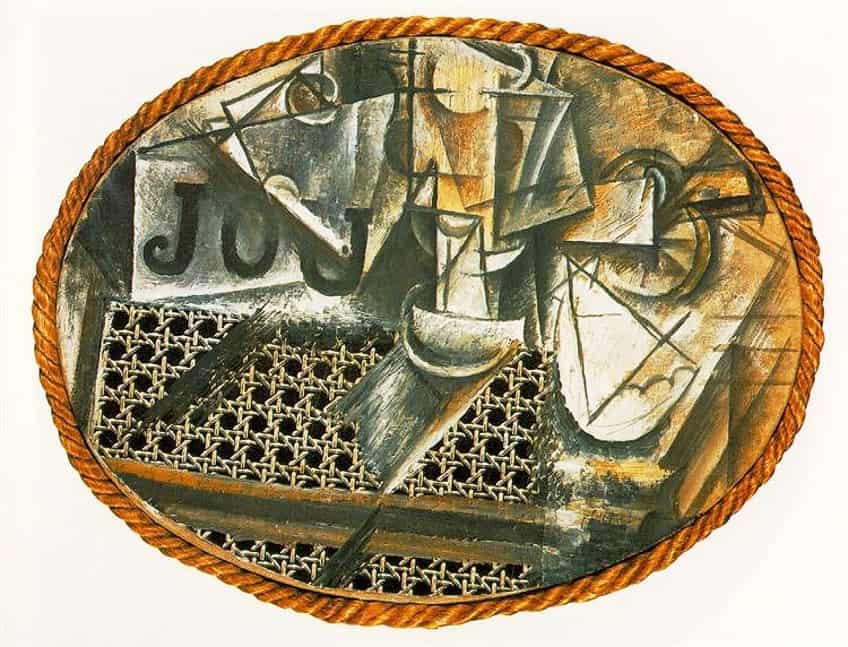
Ma Jolie (1912)
| Date | 1912 |
| Medium | Oil on canvas |
| Dimensions (cm) | 100 x 64 |
| Where It Is Housed | Museum of Modern Art, New York City, United States |
Ma Jolie was another famous Picasso painting that saw the artist explore the boundaries between high art and popular culture. By reducing color and increasing the appearance of low-relief sculpture, Picasso moved closer to abstraction, building on the geometric contours of past works. Picasso adopted the use of painted text as part of his artwork and included advertisement typeface with the word “Ma Jolie” on the front of the work to highlight the visual aesthetics to that of a billboard.
This was the first time a painter had openly incorporated aspects of popular culture into fine art in the early 20th century.
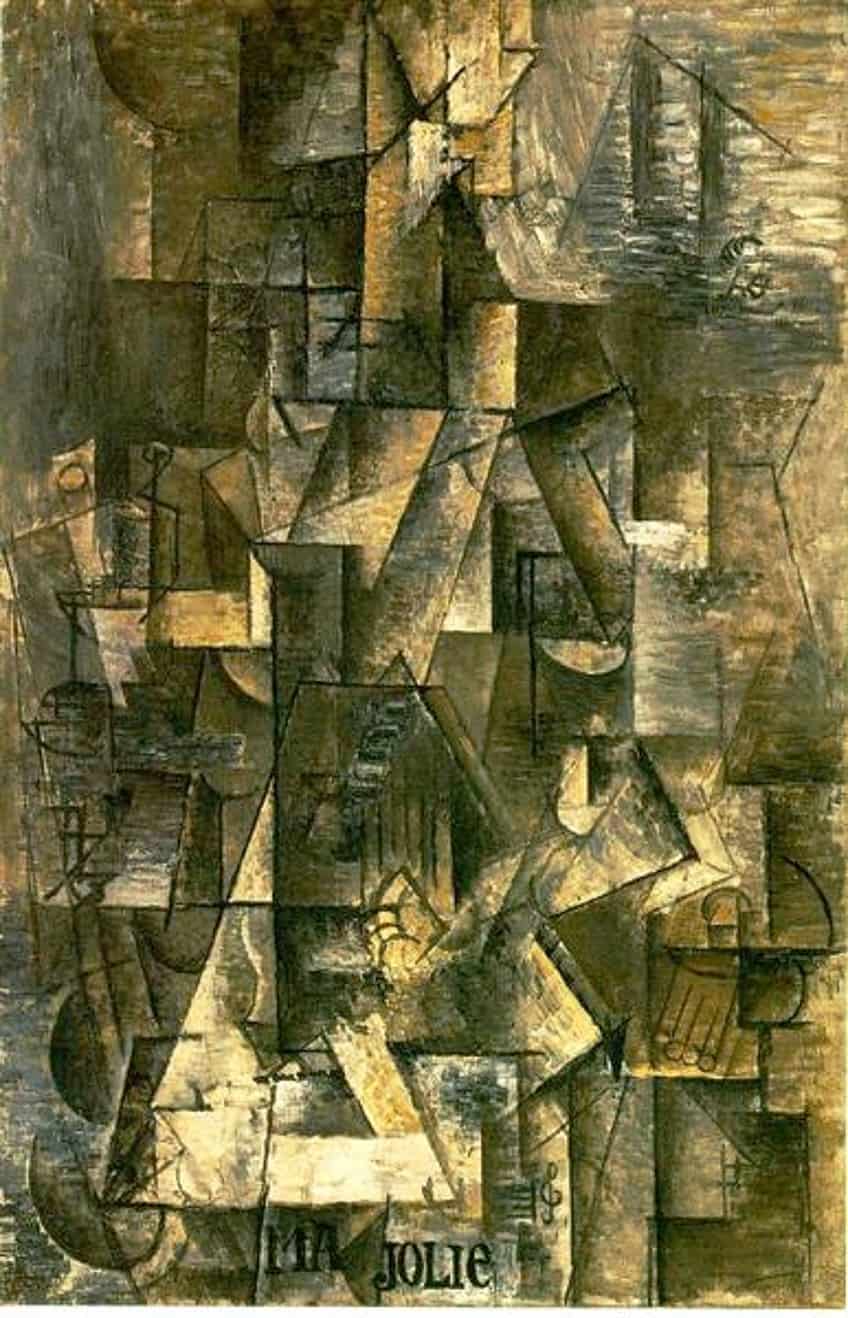
“Ma Jolie” was also recognized as the name of a famous song at the time, and became Picasso’s pseudonym for his fiancé. The figure of Ma Jolie comprised of changing planes, which was a characteristic of Analytic Cubism.
Bowl of Fruit, Violin and Bottle (1914)
| Date Completed | 1914 |
| Medium | Oil on canvas |
| Dimensions (cm) | 92 x 73 |
| Where It Is Housed | The National Gallery, London, United Kingdom |
Bowl of Fruit, Violin and Bottle was an example of Synthetic Cubism, which saw Picasso use a variety of methods to represent the perceived objects. Picasso demonstrated elements and techniques such as painted dots, shadows, and sand grains to create synthesized textures while mentally deconstructing the materials at hand. Café life summed up 20th-century Parisian life for painters like Picasso who spent considerable hours at cafes socializing with other painters.
Picasso restricted color during his Analytic Cubist period in order to focus more on the shapes and dimensions of objects, which affected his choice of still-life throughout the 20th century.
The Three Musicians (1921)
| Date | 1921 |
| Medium | Oil on canvas |
| Dimensions (cm) | 204 x 188 |
| Where It Is Housed | Philadelphia Museum of Art, Philadelphia, Pennsylvania, United States |
The Three Musicians formed part of a small series by Pablo Picasso, who created two separate variants of the composition. This version is recognized as the smaller version and can be viewed at the Philadelphia Museum of Art. In a small chamber, Picasso depicted three musicians illustrated as flat and vivid abstract forms. A clarinetist is spotted on the left with the guitarist in the middle, and a singer clutching music sheets on the right. The figures appear in costume and were well-known characters.
Pierrot appears in a blue and white outfit, while the Harlequin is dressed a yellow and orange costume. A table with a pipe and other belongings lie in front of Pierrot. Beneath Pierrot, one can also spot a dog, whose stomach and legs are exposed below the performer’s legs.
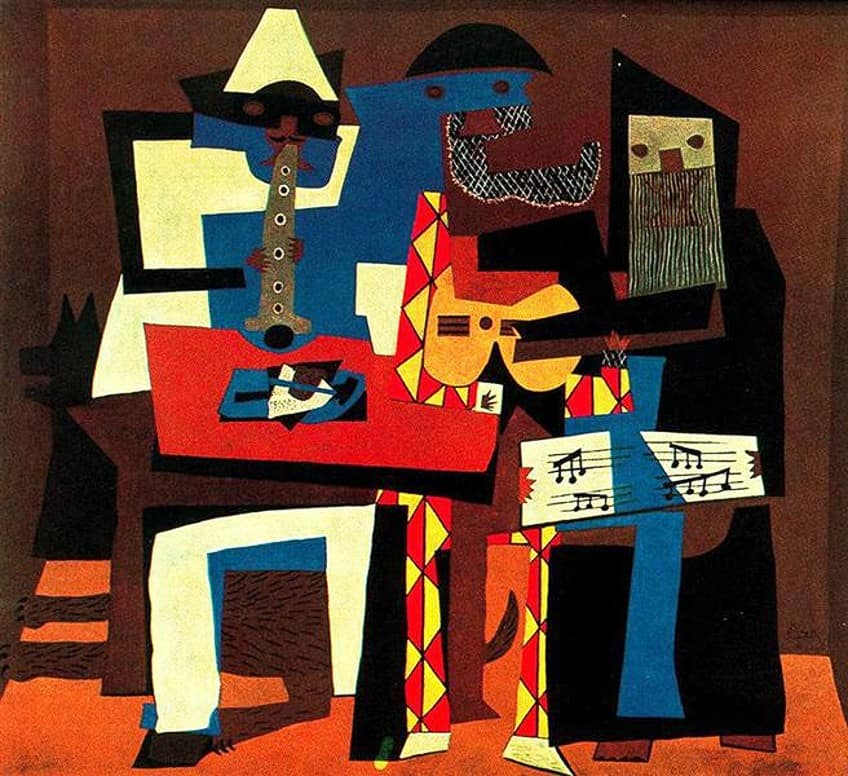
The brown flooring in the background place the musicians is in a distinct location and stretches off further to the left. The lopsided space is created by the floor and flat walls framing the composition, but the musicians appear oddly stable. All the elements in this painting were created as flat forms, including the stage on which the three musicians perform.
Three Women at the Spring (1921)
| Date | 1921 |
| Medium | Oil on canvas |
| Dimensions (cm) | 204 x 174 |
| Where It Is Housed | Museum of Modern Art, New York City, United States |
Three Women at the Spring was perhaps Picasso’s most complex depiction of a classical topic. The painting was a tribute to previous works by master painters Poussin and Ingres that draw from Greek sculpture. According to critics, the subject inspired Picasso since the period coincided with the birth of his first son, as well as the somber and melancholic mood of France in the aftermath of World War I.
The Classical Greek influence in this beautiful painting became yet another example of Picasso’s passion for Neo-Classical subjects.
In the painting, the three ladies emerge from a rocky landscape in the form of massive relief sculptures, donning chiseled features and exaggerated statuesque outlines that evoke provincial Hellenistic forms. Their high hewed features, as well as the deep-gouged lines represent the folds of their gowns, which contrast the unusual rotundity of their bodies. The dramatic breadth of the folds and the unique juxtaposition of silver, blue, and brown-orange hues make for a striking composition.
Guernica (1937)
| Date | 1937 |
| Medium | Oil on canvas |
| Dimensions (cm) | 250 x 777 |
| Where It Is Housed | Museo Nacional Centro de Arte Reina Sofía, Madrid, Spain |
Picasso created this painting in protest against the bombing of the town of Guernica on April 26, 1937, which took place during the Spanish Civil War. The painting was completed in less than a month and functioned as the focal point of the exhibition during the 1937 Parisian World’s Fair.
After the show, it was banned from being exhibited in Spain, until the overthrow of the tyrant Francisco Franco in 1975.
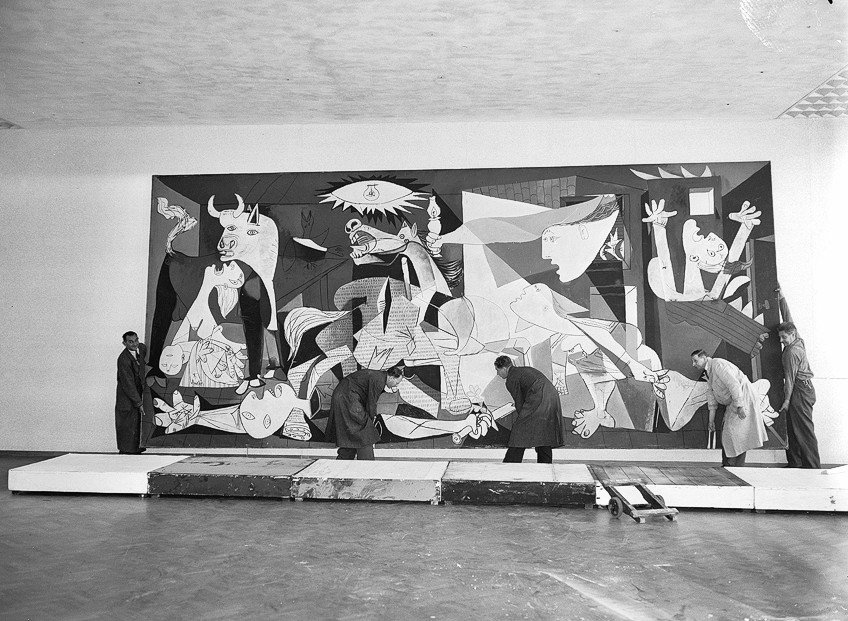
Despite causing a stir, scholars and artists spent many hours attempting to understand the meaning of Guernica, with many concluding that the suffering of the horse in the center of the composition represented the soldiers of Spain.
Portrait of Dora Maar (1937)
| Date | 1937 |
| Medium | Oil on canvas |
| Dimensions (cm) | 92 x 65 |
| Where It Is Housed | Musée Picasso, Paris, France |
Portrait of Dora Maar is perhaps one of the most famous portraits created by Picasso in 1937. Portrait of Dora Maar was painted a year after the war broke out and depicts Maar as the muse of Picasso. The portrait illustrates the artist’s lover, Dora Maar, seated on a chair, and is said to represent the struggles of women during the Spanish Civil War.
The portrait illustrates the artist’s lover, Dora Maar, seated on a chair, and is said to represent the struggles of women during the Spanish Civil War.
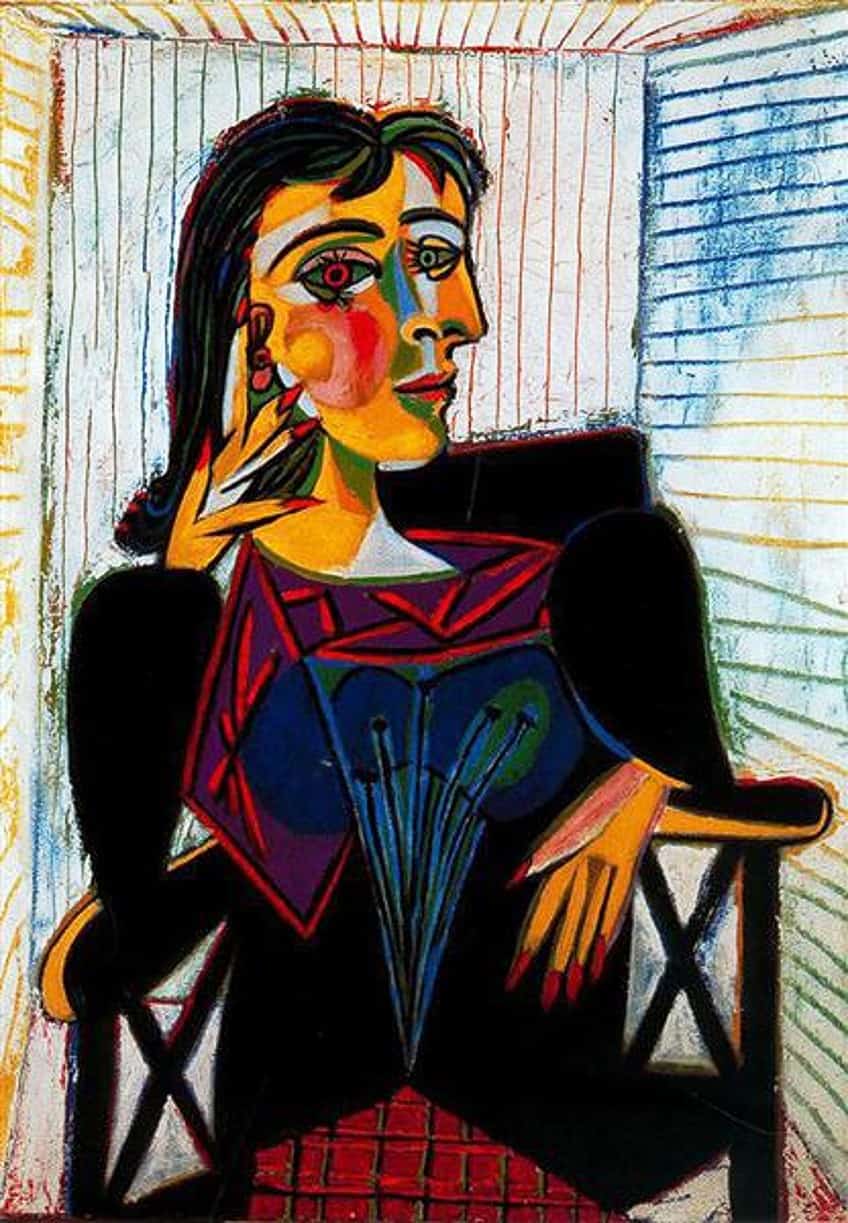
Maar encountered Picasso when she was 29 years old at Les Deux Magots, which was a popular cultural hub at the time. Today, this portrait is considered to be one of Picasso’s best masterpieces that also reminds scholars of the tumultuous history between Picasso and his lover, which lasted for nine years and ended in the diffusion of a love triangle between Picasso, the mother of his child, and Maar. Other famous paintings inspired by Maar include Dora Maar in an Armchair (1939) and Dora Maar au Chat (1941).
Self-Portrait Facing Death (1972)
| Date | 1972 |
| Medium | Crayon and pencil on paper |
| Dimensions (cm) | 65 x 50 |
| Where It Is Housed | Museo Nacional Centro de Arte Reina Sofía, Madrid, Spain |
Not only was this one of Picasso’s portraits, but this was also one of the last paintings by the Spanish artist. Picasso continued to paint until his death at the age of 91, with his preceding years resulting in a period of massive production. Pablo Picasso’s last painting was a crayon artwork, which took several months to complete, and remains one of his most famous late-career works.
According to his companion Pierre Daix, Picasso “held the drawing next to his face to emphasize that the expression of terror was a fabrication”, and added that when he returned to Picasso’s workshop months later, the drawing had grown even rougher lines.
And that brings us to the end of our list of famous Picasso paintings! Seen as a true visionary for his time, Pablo Picasso was credited as the founder of the Cubist movement, among many other achievements, which made him one of the most influential artists of the 20th century. If you have enjoyed our analyses here, there are many other Pablo Picasso artworks out there to be discovered, so get researching!
Take a look at our “Picasso’s most famous paintings” webstory here!
Frequently Asked Questions
Which Artwork Is the Most Famous Picasso Painting Ever?
Due to the sheer depth of Pablo Picasso’s artistic oeuvre, this could potentially be a very subjective question, as he created many famous works throughout his career. However, the most common answer to this question would be Picasso’s Guernica, which he painted in 1937. The painting depicts the turmoil seen in the town of Guernica after an aerial bombing during the Spanish Civil War. Additionally, Guernica is also one of the most searched-for artworks in the world, adding to its status as Picasso’s most notable artwork.
What Is Picasso’s Most Expensive Painting?
While Picasso has many artworks that have sold for millions of dollars, his most expensive painting sale to date remains Les femmes d’Alger (1955), which sold for $179.4 million in 2015. This became a record price for a painting sold on auction.
Isabella studied at the University of Cape Town in South Africa and graduated with a Bachelor of Arts majoring in English Literature & Language and Psychology. Throughout her undergraduate years, she took Art History as an additional subject and absolutely loved it. Building on from her art history knowledge that began in high school, art has always been a particular area of fascination for her. From learning about artworks previously unknown to her, or sharpening her existing understanding of specific works, the ability to continue learning within this interesting sphere excites her greatly.
Her focal points of interest in art history encompass profiling specific artists and art movements, as it is these areas where she is able to really dig deep into the rich narrative of the art world. Additionally, she particularly enjoys exploring the different artistic styles of the 20th century, as well as the important impact that female artists have had on the development of art history.
Learn more about Isabella Meyer and the Art in Context Team.
Cite this Article
Isabella, Meyer, “Famous Picasso Paintings – Analyze His 12 Must-See Artworks.” Art in Context. September 5, 2023. URL: https://artincontext.org/famous-picasso-paintings/
Meyer, I. (2023, 5 September). Famous Picasso Paintings – Analyze His 12 Must-See Artworks. Art in Context. https://artincontext.org/famous-picasso-paintings/
Meyer, Isabella. “Famous Picasso Paintings – Analyze His 12 Must-See Artworks.” Art in Context, September 5, 2023. https://artincontext.org/famous-picasso-paintings/.




